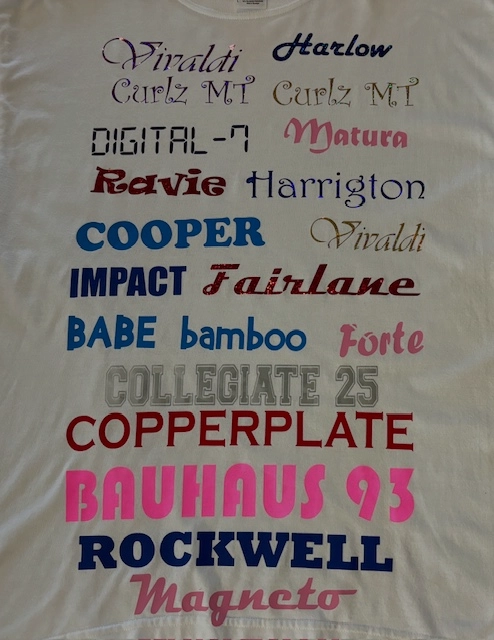The Art of Custom-made Embroidery: Opening the Keys to Creating Distinct and Remarkable Designs
Needlework, a craft steeped in custom and creativity, holds within its complex stitches the power to change fabric right into a canvas of one-of-a-kind expression. The keys to developing personalized needlework styles that astound the eye and leave a lasting impression depend on a fragile balance of strategy, creativity, and focus to detail. As we explore the globe of customized needlework, we uncover the nuanced interaction between thread option, stitch intricacy, and design customization that elevates a mere garment to a masterpiece. Join us on a journey with the art of custom-made needlework as we untangle the secrets behind crafting genuinely memorable and distinctive creations.
Selecting the Right Embroidery Threads
When picking needlework strings, what key elements should you consider to make certain the most effective outcomes for your personalized layouts? The choice of embroidery thread is important in determining the last result of your embroidered layout. Among the key factors to consider is the material of the thread. Various products such as cotton, polyester, rayon, and silk supply varying levels of sheen, durability, and structure. It is necessary to pick a thread material that enhances the fabric you are stitching on and lines up with the desired appearance of the design.
Thicker threads can include dimension and appearance to your style, while finer threads are suitable for elaborate details and little text. Additionally, considering the color fastness and washability of the thread is important to make certain that your custom styles preserve their top quality and vibrancy over time.
Discovering Different Stitch Methods
To look into the realm of 'Discovering Different Stitch Strategies', one have to grasp the complexities and subtleties that each sewing method offers the art of needlework. Different stitch methods not only include aesthetic interest yet additionally add to the total texture and dimension of the design. One popular stitch technique is the satin stitch, which involves closely jam-packed parallel stitches to create a smooth and glossy surface, perfect for filling up in shapes and developing vibrant lays out.
On the various other hand, the backstitch is a functional strategy commonly utilized for detailing and adding fine details. It involves sewing in reverse to produce a solid line of embroidery. Additionally, the French knot stitch includes a responsive aspect to styles, perfect for creating distinctive accents like flower facilities or decorative touches.
Discovering different stitch methods permits embroiderers to have fun with light, shadow, and depth within their layouts, raising the visual appeal and imaginative high quality of their embroidery tasks. By understanding different stitching approaches, one can open countless opportunities for developing unique and remarkable customized embroidery items.
Incorporating Personalized Design Aspects
Having actually checked out the complexities of various stitch techniques such as the satin stitch, backstitch, and French knot, the emphasis my link currently shifts in the direction of incorporating customized layout elements in custom-made needlework projects. Customized layout elements play a vital duty in making embroidery jobs absolutely unique and unforgettable.
An additional means to incorporate customized layout components is by including symbols or themes that hold unique definition to the recipient or reflect their interests and character. Integrating a preferred blossom, pet, or hobby-related icon can make the needlework design more meaningful and customized. useful site Furthermore, selecting colors that resonate with the recipient or line up with the designated style can additionally improve the customization of the needlework job.
Grasping the Art of Color Sychronisation

One trick element of color sychronisation is recognizing shade theory. This includes knowing just how various colors interact with each various other, the feelings they convey, and how they can be integrated to produce aesthetically enticing layouts. By using shade theory principles, embroiderers can create harmonious color combinations that improve the general appearance of the layout.
Additionally, taking notice of comparison is crucial in color sychronisation. Using contrasting colors can aid specific elements of the layout pop, boost legibility, and produce a visually vibrant needlework item. By understanding the art of shade sychronisation, embroiderers can elevate their layouts and develop remarkable items that reverberate with customers and customers alike.
Enhancing Appearance With Advanced Needlework Stitches
French knots, for example, are best for including tiny, elevated dots to your layout, resembling the appearance of grains or developing a textured surface area. Bullion knots, on the other hand, can be made use of to produce twisted, ropelike components that add an extravagant feel to the needlework. Seed stitching entails little, scattered stitches that find more information can fill up in locations with a multicolor structure, while turkey work creates fluffy, dimensional accents reminiscent of animal hair or vegetation. Explore these innovative needlework stitches permits you to press the limits of conventional embroidery and create absolutely one-of-a-kind and aesthetically attractive structures in your designs.
Verdict
To conclude, the art of custom embroidery entails a combination of choosing the appropriate threads, exploring numerous stitch methods, incorporating tailored style elements, understanding color control, and enhancing appearance with advanced stitches. By recognizing and executing these key aspects, embroiderers can develop distinct and remarkable styles that display their creativity and ability. Embroidery enthusiasts can open the tricks to developing stunning and bespoke pieces that stand out and leave an enduring impact.